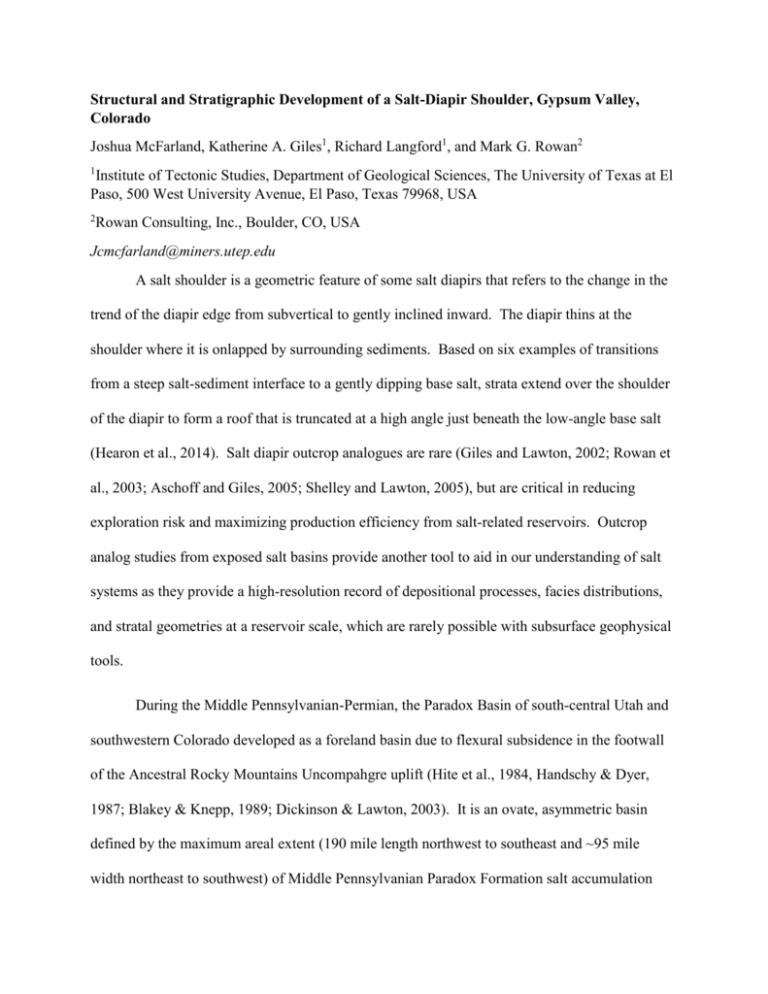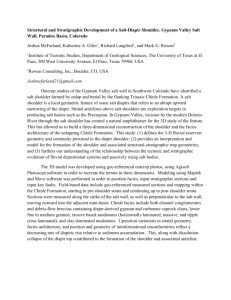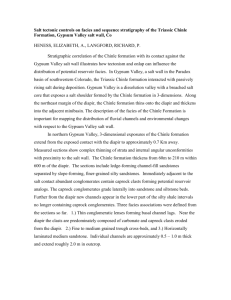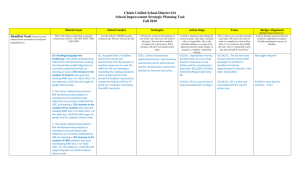Structural and Stratigraphic Development of a Salt
advertisement

Structural and Stratigraphic Development of a Salt-Diapir Shoulder, Gypsum Valley, Colorado Joshua McFarland, Katherine A. Giles1, Richard Langford1, and Mark G. Rowan2 1 Institute of Tectonic Studies, Department of Geological Sciences, The University of Texas at El Paso, 500 West University Avenue, El Paso, Texas 79968, USA 2 Rowan Consulting, Inc., Boulder, CO, USA Jcmcfarland@miners.utep.edu A salt shoulder is a geometric feature of some salt diapirs that refers to the change in the trend of the diapir edge from subvertical to gently inclined inward. The diapir thins at the shoulder where it is onlapped by surrounding sediments. Based on six examples of transitions from a steep salt-sediment interface to a gently dipping base salt, strata extend over the shoulder of the diapir to form a roof that is truncated at a high angle just beneath the low-angle base salt (Hearon et al., 2014). Salt diapir outcrop analogues are rare (Giles and Lawton, 2002; Rowan et al., 2003; Aschoff and Giles, 2005; Shelley and Lawton, 2005), but are critical in reducing exploration risk and maximizing production efficiency from salt-related reservoirs. Outcrop analog studies from exposed salt basins provide another tool to aid in our understanding of salt systems as they provide a high-resolution record of depositional processes, facies distributions, and stratal geometries at a reservoir scale, which are rarely possible with subsurface geophysical tools. During the Middle Pennsylvanian-Permian, the Paradox Basin of south-central Utah and southwestern Colorado developed as a foreland basin due to flexural subsidence in the footwall of the Ancestral Rocky Mountains Uncompahgre uplift (Hite et al., 1984, Handschy & Dyer, 1987; Blakey & Knepp, 1989; Dickinson & Lawton, 2003). It is an ovate, asymmetric basin defined by the maximum areal extent (190 mile length northwest to southeast and ~95 mile width northeast to southwest) of Middle Pennsylvanian Paradox Formation salt accumulation (Hite et al., 1984; Barbeau, 2003). The Gypsum Valley anticline is about 30 miles long and trends northwesterly (Cater & Craig, 1970), Both ends of the anticline plunge gently into the subsurface and die out along strike into flat-lying strata (Cater, 1970). Gypsum Valley, unlike the Paradox Valley and Sinbad Valley anticlines, is a structural feature complete in itself and not a segment of a much longer structure (Cater, 1970). Modern incision of the salt shoulder by the Dolores River has exposed the upper Triassic Chinle Formation unconformably onlapping carbonate caprock and Paradox Formation evaporites in a natural amphitheater. This relationship allows for the study of salt tectonically derived processes within the sediment of the Chinle Formation. Little research has been conducted on salt-sediment interaction or development of halokinetic sequences in fluvial depositional systems (Matthews et al., 1997; Waidmann, 2004; Andrie, 2012). Matthews et al. (2007) studied controls on reservoir facies distribution and architecture in the fluvio-lacustrine Triassic Chinle Formation in the Paradox Basin of southeastern Utah and found that the main controls on facies architecture were regional subsidence, local differential accommodation space and local paleo-geomorphology. They interpreted Chinle units containing amalgamated braided fluvial channels to represent periods of relatively low local accommodation that allowed rivers to flow freely across minibasins and salt structures (Matthews et al., 2007, Andrie et al., 2012). Conversely, they interpret single-story isolated channels to represent periods of relatively high local accommodation where meandering rivers became confined within minibasins (Matthews et al., 2007, Andrie et al., 2012). To complete a detailed mapping analysis of the salt shoulder I will complete 12 measured sections extending through the Chinle Formation and to the base of the Wingate Formation. Each facies boundary will be located using a GPS, to provide a 3-dimensional location. These sections will provide a framework of facies that can be traced laterally from their location within the measured sections. This will produce a facies map that will include traced depositional facies as well as unconformities, debris flows, and other salt influenced features of the Chinle Formation. In order to make a three-dimensional model of the salt shoulder, a point cloud based off of photomosaics will be created using photogrammetry software AgiSoft Photoscan. Subsequent editing in Vulcan Maptek software combined with annotating lateral transitions in facies using the software Move allows for a three dimensional interpretation of the facies distribution within the Chinle Formation on the flank of the salt wall. The three dimensional model will illustrate the variability of facies relationships and structural displacement along the margins of the shoulder.









